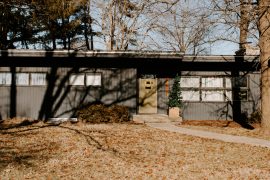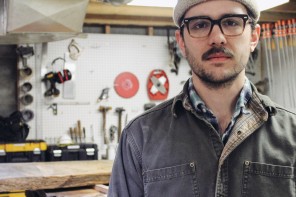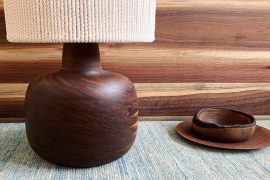July’s Maker of the Month is Nicholas Cramer, a self-taught woodworker and pottery-maker with 15 years experience who created Big Tooth Co. in 2015 to showcase and sell his various hardwoods and ceramics. While using his hands to create beautiful pieces is truly his passion, he enjoys the story that the trees tell through the work he creates. Read on to learn about his process and his craft, and what makes him a unique creator.
What piqued your initial interest in designing your product(s)? I have always been interested in building, designing, and working with my hands. I was that young kid that would meticulously take apart the lawn mower and put it back together just because, or figure out a way to install a computer fan in the combustion chamber of a potato gun. Furniture design started in Woodruff Place though. I had a neighbor across the street from my house cut down a dying ash tree in their front yard. Intrigued, I watched the tree service cut it down and haul it away log by log. The crew told me the logs were going to a green dump, which is a landfill for biodegradable waste. It seemed like such a waste of good wood, so being a broke musician at the time I thought I might be able to make some cool stuff to sell for extra cash. I asked the neighbors and tree crew if I could snag a few logs and they didn’t mind at all. Next thing I knew I bought a used chainsaw for sixty bucks and then ended up selling a few live edge tables making more than I ever did playing music, ha! . I was hooked on the whole process!
What principles do you use when designing? Balance and symmetry are a big part of my designs in both woodworking and ceramics. I rely on these principles in all my work because I think it tends to make each piece a bit more timeless and classic, and I build everything with quality to last, so it needs to be timeless. Showcasing the variety we naturally see in wood color or movement within wood grain is also important to me. Wood is the main ingredient, and I want my pieces to look and feel as such. With ceramics, throwing on the wheel is almost always symmetrical. I often try to strike a contrast by using wood and steel, pairing two different wood species, or glazing ceramic exteriors starkly different than interiors.



Who and/or what influences your design style? How would you describe your design aesthetics and values? I would describe my design as simple, clean, and sometimes geometric. The less flashiness, the better in my eyes. The wood is already beautiful – just let it do its thing. Again, I hope that simplicity leads to timelessness. As for influences, Greg Klassen, the original creator of the river table, makes most of his pieces with blue glass, and they look so darn classy. The simplicity of his leg designs are also an inspiration. I really dig Matt Cremona for his gutsy nature. If he needs a tool, or a lift, or a mill, he just builds it himself. I respect that kind of attitude and gumption. Phillip Morley is another favorite of mine. He’s got a very clean style and his joinery is top-notch. Like me, all those guys are fathers, which I think is an added reason why their style of work and success resonates with me.
What comes first for you, the design materials or the design concept? Because I salvage and mill 95% of my wood, the design materials definitely come before the concept. Working with homeowners, realtors, and developers to save logs from chippers is one of my greatest joys. That‘s not to say that I don’t look forward to making something I have dreamed up in my head though. Table legs are usually my opportunity to get creative or design something unique and new. In those cases, the design concept comes before the material.

Could you describe the process of creating a piece – from conception to finish? The creative process as well as material selection and labor process, too? Creating a new piece breaks really down into two broad categories. Receiving a commission for a piece, or designing my own idea. Both allow creative freedom, but in their own different way. With a commission there is usually dimension, a style, or piece that somebody is looking for, and this can narrow down the creative process and material selection quite a bit. From there, I tend to collaborate with the client on what directions we could go with their commission. I especially enjoy this part when I get a sense of excitement from the customer. Making things out of wood should be exciting! That said though, taking on a commission is the more rigid approach to design.
For pieces that I dream up, I will typically sort through sketches or images of pieces I admire to establish a jumping off point. There could be a particular slab on-hand that inspires me too.
Some slabs are just begging to be turned into a coffee tables, while others are better suited as rows of floating shelves. The wood tells me what to do with it sometimes! Compared to the commissioned work, this design process is a more fluid approach where an intended idea is occasionally forced to go in a slightly different direction than planned – which is all part of the problem-solving fun.
With either approach, there is certainly a great deal of planning and work that goes into using salvaged wood. First, the wood needs milled, and then it needs to dry which takes up to 2 years of air-drying or ~3 months of solar kiln drying. Unfortunately a downside to this model is wood selection. If I rarely come across a hickory log then I will rarely have hickory to use. Of course, there’s always the option to reach out to locals who mill wood too.
Regarding the labor and building process, I try to stay away from hardware as much as possible, unless the hardware is a key part of the design. Sometimes it is critical that a bed frame be able to break down into manageable pieces, or that steel legs attach to a table top. In most other cases, using traditional joinery is simply stronger and lasts longer, and it also looks way better than filling wood with a bunch of screws. Some modern tools like domino joiners seriously speed up and make ease of traditional joinery processes too.
What is your favorite tool, and why? My favorite tool is probably my 65mm Japanese block plane. When tuned well it pulls some seriously thin shavings which is just too much fun to do. It also doesn’t require electricity to use it which makes the tool all that more awesome. If I had to pick a favorite power tool, it would have to be my Stihl MS661 chainsaw and alaskan mill…for obvious reasons! It’s a beast!
Describe a piece you’ve created that you are most proud of. What was special about it? This is definitely a corner bookshelf made with live edge ash slabs. It is my most original design of which I have improved upon over the past several years. It is basically a log cut into 4-5 round slab shelves that ascend up a central backing “spine”. I wanted it to look like a tree trunk was growing within the corner of the room. Of course large sections of said tree need to be missing to make open space for objects, but I still hoped it to evoke the imagery of a tree trunk. One of these days I want to make one that stretches floor to ceiling.



What advice would you give to aspiring designers like yourself? From the business perspective: Sometimes you don’t need a start-to-finish plan, you just need the courage to jump in. Being self employed is not supposed to be easy. From the design perspective: Sketch (I don’t do this enough), and follow other artists/makers like and unlike you. Build things outside of your comfort zone.
What is one thing that the creative/design community can do in Indianapolis to help grow an audience for custom or hand-crafted work? In a perfect world we would all buy each other’s work. We would also collaborate with each other whenever possible. Our works often interface with others’ work, so why not?
Dream commission/client? I live barbecue, and that’s not a typo. So, building an array of tables and/or functional pieces for a barbecue restaurant would be a dream. Butcher block countertops, anyone?
What makes your work different from anyone else’s? Without a tree growing, you cannot have wood furniture. What makes my work different is that I can show and tell you exactly where each tree stood and grew that makes your piece. It might sound corny, but these trees are something that should be honored. Decades and even centuries of time went into everything made of wood. Yes, I put long hours into my pieces, but the tree put in so much more dedication. I see that as a beautiful thing. Most of my logs come from inner-city Indianapolis, but some come from northern Indiana too. I know I am definitely not the first guy to pride themselves in salvaging wood, but it is still not super common.

What’s your most rewarding memory in your business? It has got to be when I delivered an 11’ dining table to a customer 3 hours north of Indianapolis. It was my first piece this large, and I had no other choice but to strap it to the top of my Subaru Forester. The table was like a sail on top of the car driving up US 31. Of course it was the windiest day of the year, and it also rained a bit. If we would have blown away I think I would have been okay with it. To go along with that table I delivered a full set of dinnerware as well, so there was a lot of emotional investment in the commission. After attaching the legs and crawling out from under the table I felt like I had just accomplished the impossible. There was definitely a moment where I stepped back and realized how far I had come with Big Tooth Co.. There were some serious challenges during the build and in life at that time, and I felt like I had grown personally in overcoming all of those challenges. The fruits of my labor were showing.
Follow Big Tooth Co. on instagram and shop at www.bigtoothco.com




